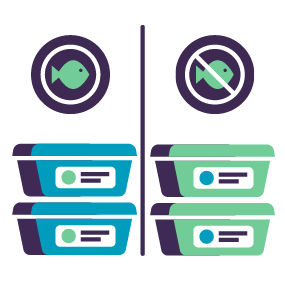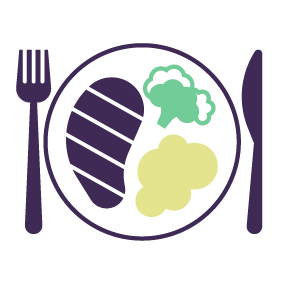Online Allergy Training
Module 5 – Introduction
A severe food allergy can cause a life-threatening reaction and even a tiny trace can be enough to cause an allergic reaction. It is important that you and your staff are aware of the composition of the foods you sell to enable you to cater for customers with food allergies and intolerances. Food allergens cannot be removed by cooking, so they need to be managed carefully.
Food businesses need to understand their own processes and products and identity, manage and communicate allergen risk to their staff and customers who have allergies to certain foods. Allergen management can easily be done in three steps:
- Identifying allergens
- Manage allergen risks
- Communicate and train your staff
Identifying allergens
The table below lists the most common allergens and provides examples of foods which typically contain them:
| Allergens | Examples of typical foods which contain this allergen (Please note this list is not exhaustive) |
|---|---|
| Cereals containing Gluten e.g. wheat (such as spelt and khorasan wheat), rye, barley, oats | Bread, pasta, cakes, pastry, sauces, soups, batter, stock cubes, breadcrumbs, semolina, couscous, some meat products |
| Celery and Celeriac e.g. stalks, seeds and leaves | Salads, soups, celery salt, some meat products |
| Eggs | Cakes, sauces, pasta, mayonnaise, some meat products, glazed products |
| Fish, e.g. all fish, | Some salad dressings, fish extracts, oils and paste, soy and Worcestershire sauces, relishes |
| Crustaceans e.g. prawns, lobster, crab,langoustines | Seafood soups & stews e.g. bouillabaisse, seafood flavourings |
| Molluscs e.g. clams, mussels, oysters, octopus | Seafood soups and stews e.g. bouillabaisse, some processed foods e.g. Oyster sauce |
| Milk | Milk powder, yoghurt, butter, cheese, cream, ghee, foods glazed with milk, ice cream, some protein powders |
| Mustard | Mustard paste, seeds, leaves, flour, powder and liquid mustard, salad dressings, marinades, soups, sauces, curries, some meat products |
| Peanuts | Arachis oil, peanut butter, flour, satay sauce peanut oil |
| Nuts e.g. almond, hazelnut, walnut, cashew, pecan, Brazil, pistachio, macadamia/Queensland nuts | In sauces, desserts, bread, crackers, ice cream, praline (hazelnut), nut butters, essences and oils, marzipan and frangipane (almond), pesto, nut salad dressings |
| Sesame seeds | Oil or paste, tahini, houmous, halva, furikake, Gomashio, bread |
| Soya | Some ice cream, sauces, desserts, meat products, vegetarian products, flour, tofu or beancurd, textured soya protein, soy sauce, edamame beans |
| Sulphur Dioxide and Sulphites | Some meat products, stock cubes, bouillon mix, fruit juice drinks, dried fruit/vegetables, wine, beer, cider |
| Lupin | Some types of bread and pastries, seeds, flour. |
Deliveries and Labels

- Check that the food delivered matches your order. If it does not match, check the ingredient list of the replacement product. Never accept a delivery without it being fully labelled with an ingredient list.
- Be aware of hidden ingredients, for example, nuts used in the base of a cheesecake.
- Any foods whose ingredients are unknown to you or you are unsure about, will require further investigation before the allergen status of that food can be verified.
Storage and avoiding cross-contamination

- Keep allergens separate from other foods and follow advice for avoiding cross-contamination in the kitchen.
- Store foods that contain allergens separate from other foods and consider using clearly marked or colour-coded containers.
- Store foods that contain allergens in powdered form, such as milk powder, or flour in air-tight containers.
- Do not lose the original product description following unpacking, decanting and storage.
- Keep a record of all foods and ingredients purchases by you to ensure traceability.
- Put in place steps to prevent cross-contamination between foods that contain allergens and foods that do not e.g. not using the same spoon for spices and nut powders and not having open containers on kitchen benches and worktops.
- Consider garnishes & accompaniments. – do these contain allergens that need to be considered? e.g. swirl of crème fraiche on soup, croutons etc.
Preparing food and drink

- Know all the ingredients in the food you handle to ensure you provide accurate allergen advice to customers
- When preparing or serving food for an allergy sufferer always:
- Use a separate area to prepare the food
- Clean and disinfect the work surface, equipment and serving utensils first, N.B. Not all equipment can be fully sanitised like tandoori ovens etc.
- Wash your hands thoroughly
- Check all ingredients listed on pre-packed foods, including secondary ones e.g. thickeners for sauces
- Do not cook food in oil in which you have cooked other foods
- Do not remove allergenic ingredients, such as nuts, from a dish and call it allergy-free because residues of the allergenic ingredient may remain in the dish and may still cause a reaction
- When displaying food in buffets or display cabinets, always lay out dishes in a way that will minimise the risk of allergen-free food being contaminated with ingredients from another dish and provide dedicated allergen serving utensils.
Cooking
A business has a legal obligation to produce food that is safe which means you need to know what allergens are in all of the food you sell. This can be done either by checking ingredient lists or asking suppliers to provide allergen information.
A food containing even a tiny trace of an allergen can cause an allergic reaction and regardless of how much the food is cooked, the allergen cannot be removed. This means it is very important to consider the cooking processes used when preparing food for allergic customers.
- Before preparing food, clean all work surfaces and equipment thoroughly using hot, soapy water to remove traces of anything that was cooked before.
- Keep allergens separate from other foods and follow advice for avoiding cross-contamination in the kitchen.
- Double check ingredients listed on pre-packed foods for allergens e.g. Worcester sauce, condiments, stock cubes, thickeners or garnishes.
- Be aware of allergens in any alcoholic drinks added to dishes e.g. cereals containing gluten in beer, sulphites in red wine and milk or egg in liquor products. For alcoholic drinks with no ingredients list, allergens are indicated by the word ‘contains’ followed by the name of the allergen.
It is also important to consider the use of communal equipment in a kitchen when preparing food for allergic customers. Here are some examples:
Deep fryers
- Has the oil been used to cook food containing the allergen? If so, this oil cannot be used to prepare allergen free food. The fryer must be emptied, thoroughly cleaned & refilled with fresh oil to prevent contamination.
- If this is not possible then consider whether the food can be prepared via shallow frying in a clean pan with fresh oil.
Toastie makers/panini presses
- Has the equipment been used to prepare food containing the allergen? If so, the cooking surfaces needs thoroughly cleaned with hot soapy water before you prepare food for customers with food allergies
- As an alternative, consider whether the dish can be prepared using a clean oven tray and a grill.
Woks
- If cooking equipment is not washed between dishes e.g. a ‘seasoned’ wok, it cannot be used to prepare allergy free food.
- Instead of using this type of equipment, consider whether allergen free dishes can be prepared using equipment which can be thoroughly cleaned with hot soapy water.
Communicate and train staff

Food allergies can kill; talk to your staff about the risks and train them in allergy awareness
All staff should get basic training in food allergen management before they first start work and receive regular refresher training. All training carried out should be accurately documented and recorded. All staff should be trained to handle any customer allergen queries and understand the potential severity of not handling allergens and allergen information correctly.
Make sure that all staff understand that they should never guess whether or not an allergen is present in a food. They should ask someone who knows. Always be honest with the customer. If you do not know, admit it!
Some points to consider when developing training for staff members:
| Management | Kitchen | Front of house | Takeaway/delivery |
|---|---|---|---|
| Check all allergen and paperwork and documents for accuracy | Ensure there is knowledge and awareness on allergen risks and controls | Have knowledge and awareness of allergen risks and control | When receiving orders via phone, ensure that the member of staff asks if the customer has any allergies |
|
Managements knowledge and awareness of allergen risks and controls
|
Create standard recipes to ensure all kitchen staff are aware of what allergens are contained in what dishes |
Trained to respond to allergen queries from customers
|
Never guess as to the ingredients in a dish
|
|
Make sure that all staff members are trained on allergen risks and controls
|
Responsible for cleaning and disinfection within the kitchen |
Know that they must inform other relevant staff members of any customers who suffer from allergies, for example, chefs |
If you use online menus etc, you should signpost that customers should make you aware of any allergies |
|
Ensure that staff consider any food they take onto the premises for personal consumption especially before handling allergen free foods e.g gluten containing bread, peanut bars |
Take extra care when dealing with requests for allergen free dishes. |
Where orders are made online, staff should additionally inform the kitchen about the allergen free order
|
Food being delivered that is allergen free should be labelled as such and should be packaged separately and away from any foods that contain the allergen, ideally in its own bag to avoid cross contamination |
| _ | Have procedures in place to ensure all staff are informed of any last minute recipe changes | Never guess as to the ingredients in a dish | All foods produced must contain correct labelling (where applicable) |
Before you begin the quiz
The following two questions are optional and help us with our reporting and providing you a better service.